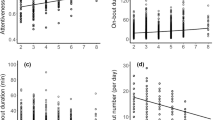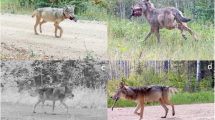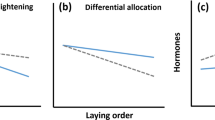Abstract
Providing food to developing offspring is beneficial for offspring but costly for carers. Understanding patterns of provisioning thus yields important insights into how selection shapes (allo-) parental care strategies. Broadly, offspring development will be influenced by three components of provisioning (prey type, size and delivery rate). However, all three variables are rarely considered simultaneously, leading to suggestions that the results of many studies are misleading. Additionally, few studies have examined the provisioning strategies of breeders and non-breeding helpers in obligate cooperative breeders, wherein reproduction without help is typically unsuccessful. We investigated these components of provisioning in obligately cooperative chestnut-crowned babblers (Pomatostomus ruficeps). Prey type was associated with size, and delivery rate was the best predictor of the overall amount of food provided by carers. As broods aged, breeders and helpers similarly modified the relative proportion of different prey provided and increased both prey size and delivery rate. Breeding females contributed less prey than male breeders and adult helpers, and were the only carers to load-lighten by reducing their provisioning rates in the presence of additional carers. While our results suggest that breeders and helpers follow broadly comparable provisioning rules, they are also consistent with the idea that, in obligately cooperative species, breeding females benefit more from conserving resources for future reproduction than do helpers which have a low probability of breeding independently.



Similar content being viewed by others
References
Arnold KE, Ramsay SL, Donaldson C, Adam A (2007) Parental prey selection affects risk-taking behaviour and spatial learning in avian offspring. Proc R Soc Lond B 274:2563–2569
Bañbura J, Lambrechts MM, Blondel J, Perret P, Cartan-Son M (1999) Food handling time of blue tit chicks: constraints and adaptation to different prey types. J Avian Biol 30:263–270
Bates D, Maechler M, Bolker BM (2011) lme4: linear mixed-effects models using S4 classes. http://CRAN.R-project.org/package=lme4
Boland CRJ, Heinsohn R, Cockburn A (1997) Experimental manipulation of brood reduction and parental care in cooperatively breeding white-winged choughs. J Anim Ecol 66:683–691
Brown JL (1987) Helping and communal breeding in birds. Princeton University Press, Princeton
Browning LE, Patrick SC, Rollins LA, Griffith SC, Russell AF (2012) Kin selection, not group augmentation, predicts helping in an obligate cooperatively breeding bird. Proc R Soc Lond B 279:3861–3869
Canestrari D, Chiarati E, Marcos JM, Ekman J, Baglione V (2008) Helpers but not breeders adjust provisioning effort to year-round territory resource availability in carrion crows. Anim Behav 76:943–949
Clutton-Brock TH (1991) The evolution of parental care. Princeton University Press, Princeton
Clutton-Brock TH, Hodge SJ, Spong G, Russell AF, Jordan NR, Bennett NC, Sharpe LL, Manser MB (2006) Intrasexual competition and sexual selection in cooperative mammals. Nature 444:1065–1068
Clutton-Brock TH, Russell AF, Sharpe LL (2004) Behavioural tactics of breeders in cooperative meerkats. Anim Behav 68:1029–1040
Clutton-Brock TH, Russell AF, Sharpe LL, Young AJ, Balmforth Z, McIlrath GM (2002) Evolution and development of sex differences in cooperative behavior in meerkats. Science 297:253–297
Cornwallis CK, West SA, Griffin AS (2009) Routes to indirect fitness in cooperatively breeding vertebrates: kin discrimination and limited dispersal. J Evol Biol 22:2445–2457
Cowie RJ, Hinsley SA (1988) Feeding ecology of great tits (Parus major) and blue tits (Parus caeruleus), breeding in suburban gardens. J Avian Biol 57:611–626
Dickinson JL, Hatchwell BJ (2004) Fitness consequences of helping. In: Koenig WD, Dickinson JL (eds) Ecology and evolution of cooperative breeding in birds. Cambridge University Press, Cambridge, pp 48–66
Emlen ST, Wrege PH (1991) Breeding biology of white-fronted bee-eaters at Nakuru: the influence of helpers on breeder fitness. J Anim Ecol 60:309–326
Gelman A (2008) Scaling regression inputs by dividing by two standard deviations. Stat Med 27:2865–2873
Gilchrist J, Russell AF (2007) Who cares? Individual contributions to pup care by breeders vs non-breeders in the cooperatively breeding banded mongoose (Mungos mungo). Behav Ecol Sociobiol 61:1053–1060
Griffiths R, Double MC, Orr K, Dawson RJG (1998) A DNA test to sex most birds. Mol Ecol 7:1071–1075
Hadfield JD (2010) MCMC methods for multi-response generalized linear mixed models: the MCMCglmm R package. J Stat Softw 32:1–22
Hamilton WD (1964) The genetical evolution of social behaviour I & II. J Theor Biol 7:1–82
Hatchwell BJ (1999) Investment strategies of breeders in avian cooperative breeding systems. Am Nat 154:205–219
Hatchwell BJ (2009) The evolution of cooperative breeding in birds: kinship, dispersal and life history. Philos T Roy Soc B 364:3217–3227
Hatchwell BJ, Russell AF, MacColl ADC, Ross DJ, Fowlie MK, McGowan A (2004) Helpers increase long-term but not short-term productivity in cooperatively breeding long-tailed tits. Behav Ecol 15:1–10
Heinsohn R (1991) Slow learning of foraging skills and extended parental care in cooperatively breeding white-winged choughs. Am Nat 137:864–881
Heinsohn R (2004) Parental care, load-lightening, and costs. In: Koenig WD, Dickinson JL (eds) Ecology and evolution of cooperative breeding in birds. Cambridge University Press, Cambridge, pp 67–80
Higgins PJ, Peter JM (2002) Handbook of Australian, New Zealand and Antarctic Birds. Volume 6: Pardalotes to Shrike-thrushes. Oxford University Press, Melbourne
Holleley CE, Russell AF, Griffith SC (2009) Isolation and characterization of polymorphic tetranucleotide microsatellite loci in the chestnut-crowned babbler (Pomatostomus ruficeps). Mol Ecol Res 9:993–995
Langen TA (1996) Skill acquisition and the timing of natal dispersal in the white-throated magpie-jay, Calocitta formosa. Anim Behav 51:575–588
Legge S (2000) Helper contributions in the cooperatively breeding laughing kookaburra: feeding young is no laughing matter. Anim Behav 59:1009–1018
Lindström J (1999) Early development and fitness in birds and mammals. Trends Ecol Evol 14:343–348
MacColl ADC, Hatchwell BJ (2003) Sharing of caring: nestling provisioning behaviour of long-tailed tit, Aegithalos caudatus, parents and helpers. Anim Behav 66:955–964
Maynard Smith J (1964) Group selection and kin selection. Nature 201:1145–1147
Metcalfe NB, Monaghan P (2001) Compensation for a bad start: grow now, pay later? Trends Ecol Evol 16:254–260
Monaghan P, Nager RG (1997) Why don’t birds lay more eggs? Trends Ecol Evol 12:270–274
Nam K-B, Meade J, Hatchwell BJ (2011) Do parents and helpers adjust their provisioning effort in relation to nestling sex in a cooperatively breeding bird? Anim Behav 82:303–309
Portelli DJ, Barclay H, Russell DJF, Griffith SC, Russell AF (2009) Social organisation and foraging ecology of the cooperatively breeding chestnut-crowned babbler (Pomatostomus ruficeps). Emu 109:153–162
R Development Core Team (2011) R: a language and environment for statistical computing. R Foundation for Statistical Computing, Vienna
Rabenold KN (1985) Cooperation in breeding by nonreproductive wrens: kinship, reciprocity, and demography. Behav Ecol Sociobiol 17:1–17
Radford AN (2008) Age-related changes in nestling diet of the cooperatively breeding green woodhoopoe. Ethology 114:907–915
Ramsay SL, Houston DC (2003) Amino acid composition of some woodland arthropods and its implications for breeding tits and other passerines. Ibis 145:227–232
Rollins LA, Browning LE, Hollely CE, Savage JL, Russell AF, Griffith SC (2012) Building genetic networks using relatedness information: a novel approach for the estimation of dispersal and characterization of group structure in social animals. Mol Ecol 21:1727–1740
Royama T (1970) Factors governing the hunting behaviour and selection of food by the great tit (Parus major L.). J Anim Ecol 39:619–668
Russell AF, Langmore NE, Gardner JL, Kilner RM (2008) Maternal investment tactics in superb fairy-wrens. Proc R Soc Lond B 275:29–36
Russell AF, Portelli DJ, Russell DJF, Barclay H (2010) Breeding ecology of the chestnut-crowned babbler: a cooperative breeder in the desert. Emu 110:324–331
Schielzeth H (2010) Simple means to improve the interpretability of regression coefficients. Methods Ecol Evol 1:103–113
Sheldon BC (2000) Differential allocation: tests, mechanisms and implications. Trends Ecol Evol 15:397–402
Solomon NG, French JA (1997) Cooperative breeding in mammals. Cambridge University Press, Cambridge
Sorato E, Gullett PR, Griffith SC, Russell AF (2012) Effects of predation risk on foraging behaviour and group size: adaptations in a social cooperative species. Anim Behav 84(4):823–834
Stacey PB, Koenig WD (1990) Cooperative breeding in birds: long-term studies of ecology and behavior. Cambridge University Press, Cambridge
Stearns SC (1992) The evolution of life histories. Oxford University Press, Oxford
te Marvelde L, McDonald PG, Kazem AJN, Wright J (2009) Do helpers really help? Provisioning biomass and prey type effects on nestling growth in the cooperative bell miner. Anim Behav 77:727–735
Williams GC (1966) Natural selection, the costs of reproduction, and a refinement of Lack’s principle. Am Nat 100:687–690
Woxvold IA, Mulder RA, Magrath MJL (2006) Contributions to care vary with age, sex, breeding status and group size in the cooperatively breeding apostlebird. Anim Behav 72:63–73
Wright J (1998) Helpers-at-the-nest have the same provisioning rule as parents: experimental evidence from play-backs of chick begging. Behav Ecol Sociobiol 42:423–429
Wright J, McDonald PG, te Marvelde L, Kazem AJN, Bishop CM (2010) Helping effort increases with relatedness in bell miners, but “unrelated” helpers of both sexes still provide substantial care. Proc R Soc Lond B 277:437
Young CM, Browning LE, Savage JL, Griffith SC, Russell AF (2012) No evidence for deception over allocation to brood care in a cooperative bird. Behav Ecol. doi:10.1093/beheco/ars137
Zuur AF, Ieno EN, Walker N, Saveliev AA, Smith GM (2009) Mixed effects models and extensions in ecology with R. Springer, New York
Acknowledgments
We thank Dr. David Croft, Garry and Vicky Dowling and Zane Turner for logistical support at Fowlers Gap; UNSW for permission to work there; Elena Berg, Sam Patrick, Bec Rose and Beth Woodward for fieldwork; Clare Holleley and Lee Ann Rollins for molecular work; Stanislaw Zabramski and Michael Magrath for designing and making the PIT tag system; Tim Clutton-Brock, Nick Davies and Ben Hatchwell for helpful discussion; James Gilbert, Stuart Sharp, Sjouke Kingma and two anonymous referees for valuable comments on the manuscript; and James Gilbert for help with MCMCglmm. This work was funded by grants from the Natural Environment Research Council [studentship to University of Cambridge (LEB)] and New Investigator’s (AFR), Marmaduke Shield Fund (LEB), Australian Research Council Discovery Grant (AFR) and the Royal Society University Research Fellowship Scheme (AFR).
Ethical standards
Fieldwork was carried out under the approval of UNSW Animal Care and Ethics Committee (license no. 06/40A) and the authority of NSW National Parks and Wildlife Service and the Australian Bird and Bat Banding Scheme.
Conflict of interest
None.
Author information
Authors and Affiliations
Corresponding author
Additional information
Communicated by P. A. Bednekoff
Rights and permissions
About this article
Cite this article
Browning, L.E., Young, C.M., Savage, J.L. et al. Carer provisioning rules in an obligate cooperative breeder: prey type, size and delivery rate. Behav Ecol Sociobiol 66, 1639–1649 (2012). https://doi.org/10.1007/s00265-012-1419-z
Received:
Revised:
Accepted:
Published:
Issue Date:
DOI: https://doi.org/10.1007/s00265-012-1419-z




